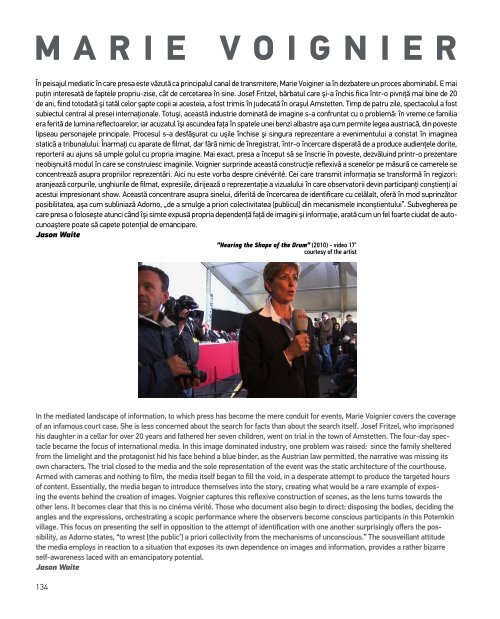Catalogue Police the police
Catalogue Police the police
Catalogue Police the police
Create successful ePaper yourself
Turn your PDF publications into a flip-book with our unique Google optimized e-Paper software.
M A R I E V O I G N I E R<br />
În peisajul mediatic în care presa este văzută ca principalul canal de transmitere, Marie Voiginer ia în dezbatere un proces abominabil. E mai<br />
puţin interesată de faptele propriu-zise, cât de cercetarea în sine. Josef Fritzel, bărbatul care şi-a închis fiica într-o pivniţă mai bine de 20<br />
de ani, fiind totodată şi tatăl celor şapte copii ai acesteia, a fost trimis în judecată în oraşul Amstetten. Timp de patru zile, spectacolul a fost<br />
subiectul central al presei internaţionale. Totuşi, această industrie dominată de imagine s-a confruntat cu o problemă: în vreme ce familia<br />
era ferită de lumina reflectoarelor, iar acuzatul îşi ascundea faţa în spatele unei benzi albastre aşa cum permite legea austriacă, din poveste<br />
lipseau personajele principale. Procesul s-a desfăşurat cu uşile închise şi singura reprezentare a evenimentului a constat în imaginea<br />
statică a tribunalului. Înarmaţi cu aparate de filmat, dar fără nimic de înregistrat, într-o încercare disperată de a produce audienţele dorite,<br />
reporterii au ajuns să umple golul cu propria imagine. Mai exact, presa a început să se înscrie în poveste, dezvăluind printr-o prezentare<br />
neobişnuită modul în care se construiesc imaginile. Voignier surprinde această construcţie reflexivă a scenelor pe măsură ce camerele se<br />
concentrează asupra propriilor reprezentări. Aici nu este vorba despre cinévérité. Cei care transmit informaţia se transformă în regizori:<br />
aranjează corpurile, unghiurile de filmat, expresiile, dirijează o reprezentaţie a vizualului în care observatorii devin participanţi conştienţi ai<br />
acestui impresionant show. Această concentrare asupra sinelui, diferită de încercarea de identificare cu celălalt, oferă în mod suprinzător<br />
posibilitatea, aşa cum subliniază Adorno, „de a smulge a priori colectivitatea [publicul] din mecanismele inconştientului”. Subvegherea pe<br />
care presa o foloseşte atunci când îşi simte expusă propria dependenţă faţă de imagini şi informaţie, arată cum un fel foarte ciudat de autocunoaştere<br />
poate să capete potenţial de emancipare.<br />
Jason Waite<br />
”Hearing <strong>the</strong> Shape of <strong>the</strong> Drum” (2010) - video 17’<br />
courtesy of <strong>the</strong> artist<br />
In <strong>the</strong> mediated landscape of information, to which press has become <strong>the</strong> mere conduit for events, Marie Voignier covers <strong>the</strong> coverage<br />
of an infamous court case. She is less concerned about <strong>the</strong> search for facts than about <strong>the</strong> search itself. Josef Fritzel, who imprisoned<br />
his daughter in a cellar for over 20 years and fa<strong>the</strong>red her seven children, went on trial in <strong>the</strong> town of Amstetten. The four-day spectacle<br />
became <strong>the</strong> focus of international media. In this image dominated industry, one problem was raised: since <strong>the</strong> family sheltered<br />
from <strong>the</strong> limelight and <strong>the</strong> protagonist hid his face behind a blue binder, as <strong>the</strong> Austrian law permitted, <strong>the</strong> narrative was missing its<br />
own characters. The trial closed to <strong>the</strong> media and <strong>the</strong> sole representation of <strong>the</strong> event was <strong>the</strong> static architecture of <strong>the</strong> courthouse.<br />
Armed with cameras and nothing to film, <strong>the</strong> media itself began to fill <strong>the</strong> void, in a desperate attempt to produce <strong>the</strong> targeted hours<br />
of content. Essentially, <strong>the</strong> media began to introduce <strong>the</strong>mselves into <strong>the</strong> story, creating what would be a rare example of exposing<br />
<strong>the</strong> events behind <strong>the</strong> creation of images. Voignier captures this reflexive construction of scenes, as <strong>the</strong> lens turns towards <strong>the</strong><br />
o<strong>the</strong>r lens. It becomes clear that this is no cinéma vérité. Those who document also begin to direct: disposing <strong>the</strong> bodies, deciding <strong>the</strong><br />
angles and <strong>the</strong> expressions, orchestrating a scopic performance where <strong>the</strong> observers become conscious participants in this Potemkin<br />
village. This focus on presenting <strong>the</strong> self in opposition to <strong>the</strong> attempt of identification with one ano<strong>the</strong>r surprisingly offers <strong>the</strong> possibility,<br />
as Adorno states, “to wrest [<strong>the</strong> public’] a priori collectivity from <strong>the</strong> mechanisms of unconscious.” The sousveillant attitude<br />
<strong>the</strong> media employs in reaction to a situation that exposes its own dependence on images and information, provides a ra<strong>the</strong>r bizarre<br />
self-awareness laced with an emancipatory potential.<br />
Jason Waite<br />
134


